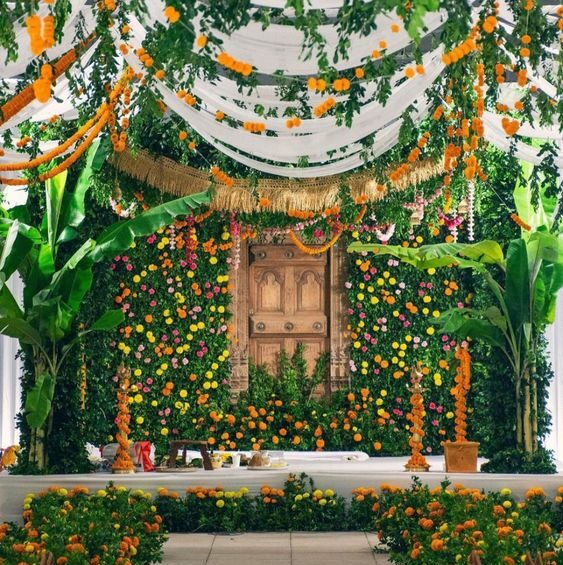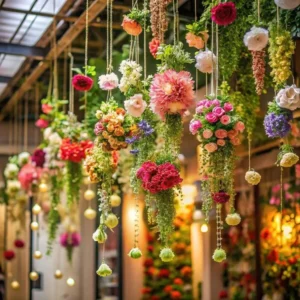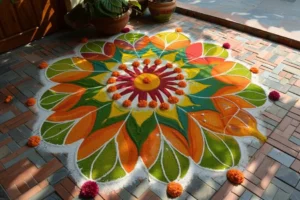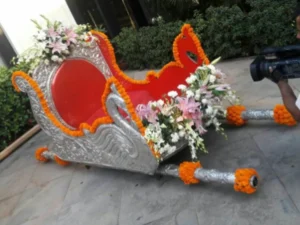Regional Look at Diverse South Indian Wedding Customs are known for their vibrancy, cultural richness, and deep-rooted traditions. Each state within South India – Kerala, Tamil Nadu, Karnataka, and Andhra Pradesh/Telangana – boasts its unique set of customs and rituals that contribute to the grandeur of these celebrations.
This article discusses the diverse pre-wedding, wedding day, and post-wedding traditions practiced in these areas, providing an insight into the richness and complexity of South Indian wedding culture. Now let’s get started by going through each custom in
Pre-South Indian Wedding Traditions
1. Kerala

In Kerala, pre-wedding rituals emphasize simplicity and meaningful traditions. Once the marriage alliance is accepted, the families meet to finalize the wedding date and perform a formal engagement ceremony. This engagement, marked by the exchange of gifts and rings, sets the stage for the upcoming nuptials.
On the eve of the wedding, both families host separate gatherings filled with music, dance, and festivities. A notable custom involves women from the groom’s family visiting the bride’s house, bringing along the wedding sari and accessories, symbolizing their acceptance and welcome of the bride into their family.
2. Tamil Nadu
There is a lot of religious importance in Tamil Nadu regarding the pre-wedding rituals. In the “Panda Kaal Muhurtham” ceremony, which is an essential event, both families receive blessings for the prosperity of the marriage. Purifying vows precede weddings and can be performed at home or in a temple to establish the proper spirit.

Also by the bride’s side a ‘Sumangali Prarthana’ is done for conjugality, which involves designing kolams using rice flour. However, during the function called as ‘Nichayathartham’, the bridegroom and his family members offer sarees, jewelries and other accessories to the bride which denotes the integration of two families.
3. Karnataka
The customs followed before marriage in Karnataka are the combined form of the customs observed in Tamil Nadu and Andhra Pradesh, which are more protracted and can last for several days. The final rite of the ceremony is the “Nischaya Tamulam,” when the bride and groom formally become engaged partners; during this, both families give presents to the couple, and sweets made of betel leaves are exchanged.

The ‘Naandi’ which is an indication of the beginning of the wedding ceremony is a ritual that pronounces the blessings in the matter of the wedding, is the mode of a copper vessel having water and the infallible condition coconut placed on the vessel.
4. Andhra Pradesh/Telangana

India being a country of colossal culture and tradition, we find pre-wedding rituals in Andhra Pradesh and Telangana cheerful. There are the “Pellikuturu” and “Pellikoduku” rites just before the marriage where the bride and groom are smeared with flour, turmeric, and aromatic oil, and then the bride is washed with turmeric water in a purification rite. The current wedding festivals that are typical to the South Indian community have embraced Mehandi, Sangeet, and Haldi ceremonies which are traditions of the North Indians.
Also Read: Traditional South Indian Wedding Attire: A Guide to Stunning
Wedding Day Traditions
1. Kerala
As observed in the case of the marriage ceremony in Kerala the day is filled with both celebrations and religious procedures. The groom and bride pay respects to their elders in the hopes of invoking their blessings to lead them to their venue. The groom is taken by the bride’s family to the stage to perform different rituals with flowers, sticks, and lamps all the while to music.

The bride is also ushered in with similar fashion into the area where she will be dancing. Ceremonies which are ‘must have’ at a wedding are Kanyadaan where the bride’s father gives his daughter’s hand in marriage and ‘thaali’ or mangalsutra ceremony where the groom puts around the bride’s neck a sacred thread. He and the wife moved again around a lamp to make the ritual more circular. Food is an essential part of the celebration; hence, an elaborate ‘Sadya’ using banana leaves is served with the preparations of typical dishes of Kerala.
2. Tamil Nadu
The Mangala Snanam marks the beginning of most Tamil Nadu functions and follows the rituals in which the bride and groom are anointed with turmeric, sandalwood, and vermillion by married women and sprinkled with holy water. The bride puts on her wedding gown and then offers puja in the morning by performing Gauri Puja.

At the venue, “Pada Puja” involves washing of the groom’s feet by the father in law – After this; the bride and groom exchange garlands thrice; then go round a swing while married women sing conjugal verses and feed them with small quantities of milk and bananas. Next is the ‘Kanyadaan’ where the groom gives the ‘thaali’ and then they complete the round of ‘Saptapadi.’ A beautiful meal is then served to mark the end of the occasion and Sunita bids farewell to her family.
3. Karnataka

Karnataka weddings begin with “Pada Puja,” followed by a ritual where a cloth is held between the bride and groom to prevent them from seeing each other until the auspicious moment. The cloth is then lowered, and the couple exchanges garlands. After “Kanyadaan” and “Saptapadi,” the groom ties the ‘thaali.’ The couple then looks for a star in the sky, believed to bless their marriage. This star-gazing ritual is both romantic and symbolic, representing the couple’s shared future and celestial guidance.
4. Andhra Pradesh/Telangana
Telugu weddings commence with Ganesh Puja at the mandapam to seek blessings. The bride performs Gauri Puja before being brought to the stage by her maternal uncle, sometimes seated in a straw basket. A cloth curtain is held between the bride and groom for the “Jeeraka-Belam” ritual, where they place a paste of jaggery and cumin on each other’s heads.

The groom then ties the mangalsutra, followed by the “Talambralu” ritual, where the couple showers each other with colored rice and beads. The “Pradhanam” ritual involves the bride and groom searching for a golden ring in a pot filled with milk and water. After garlanding each other and performing “Kanyadaan” and “Saptapadi,” they look for the stars Arundhati and Vasishta in the sky.
Post-Wedding Customs
1. Kerala
Keralites are known for their simplicity and there is no very lengthy or lavish ceremony that takes place post wedding in Kerala. The young couple goes to the house where the groom lives, and they are allowed to go in after they undergo certain ceremonies. They go to the parents of the groom for prayers and spend the first night at the home of the groom which symbolizes their wedding night. The two rituals signifying births and familial relatedness recall that people are connected in a family as they commence with a new journey.
2. Tamil Nadu
Tamil Nadu wedding customs include the post-wedding “Gruhapravesam” which escorts the bride into the home where she will live. The first event performed by the groom’s family is aarti in a thayal that aims at driving away evils. Games and rituals are also played by the couple in which the bride is to adapt to the new family that welcomes her with open arms. These are activities that are aimed at bringing close to the parties involved with the hope of warming up the new bride in her new home.
3. Karnataka
For the Karnataka region, post-wedding customs entail one to go back to the bride’s home for the Satyanarayana Puja in a bid to pray for a well-end Clementine of matrimony. The bride then leaves her parent’s home to go to the home of the groom, which is usually accompanied by a variety of colorful rites to mark the beginning of a happy conjugal life.
4. Andhra Pradesh/Telangana
Common post-wedding rites practiced in Andhra Pradesh and Telangana include Grihapravesam where the bride is ceremoniously welcomed at the home of the groom. This is occasioned by fervent bowing and decorative activities that are performed by the couple together with rituals that mark the couple’s new life. They also pay a visit to the bride’s home and partake in a celebrative meal and wishes from the side of the bride’s family, which demonstrates that they are still connected to the parental family of the bride.
Conclusion
To sum up, the South Indian weddings are a blend of wedding customs and traditions and are predominantly family-oriented. To some extent, the complexity of these celebrations is due to the fact that each region has a different tradition.
Whereas the rituals of Kerala are class simple yet with great significance, the ceremonies of Tamil Nadu, Karnataka, and Andhra Pradesh / Telangana are grand, thus giving a beautiful insight into how South Indian weddings uphold tradition while celebrating the union of two families.
From dazzling pre-wedding ceremonies to the hallowed Islamic wedding to the sweet and beautiful post-wedding customs, all these practices make such weddings memorable and endearing celebrations.
FAQ
In what ways are South Indian weddings different from the North Indian weddings?
The wedding ceremonies that are held in South Indian areas are comparatively more orthodox and ritualistic in nature with a lot of importance given to austere and spiritual appeal. These ceremonies may commence as early as five in the morning and have a preponderance of Vedic rituals. The South Indian marriage ceremony and dresses are quite simple in comparison to the elaborate and over the top North Indian nuptial functions and outfits. But they are equally culturally oriented and contain numerous ceremonial rites, like mangalsutra (thaali) tying and the sacred fire ceremonies Saptapadi.
Where does the significance of the ‘mangalsutra’ lie in South Indian marriages?
The “mangalsutra” commonly referred to as “thaali”, is a piece of sacred thread or a necklace that is put around the bride’s neck by the groom during the wedding ceremony. As earlier noted, this act is the most significant event in the marriage since it is viewed as proof of the bride’s status and signifies the marriage of the couple. Different epochs have their own designs of mangalsutras; however, all the Mangalsutras symbolize love, commitment, and marriage.
What makes a South Indian wedding start in the early morning?
South Indian wedding ceremonies start early in the morning mainly because this period is considered sacred and is called ‘Brahmamuhurta.’ This is probably why; all the rites and customs are performed during morning hours only. The early start also bears added logic since new ventures are most commonly initiated at first light as a sign of a new beginning.






